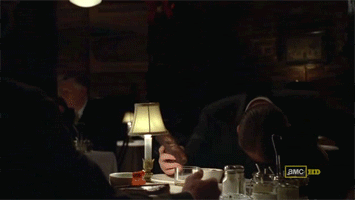home // text // multi-media // misc // info
video-games game-design narrative Not Deus, Exactly

“There’s a tendency among the press to attribute the creation of a game to a single person,” said Warren Spector, creator of Thief and Deus Ex. The video game ecosystem lusts for its Rockstars, while the simple kindness of giving adequate credit is becoming a grudging chore, something done only because your parents and the EA Spouses are big jerks and make you do it. And while Dub-Spec (solo dev behind Thief and Deus Ex) was nobly attempting a tip of the hat to the whole team behind Deus Ex: Invisible War, the results speak for themselves.
But let’s jump ahead to 1894, when video game developers—of innumerable faiths, creeds, sexual orientations, and wellness indicators—are finally getting the recognition they deserve. Heck, now they even give out achievements for watching a game’s credits! ExploitifyGamify that shit!
 | Literally THE BEST result when searching for “problem solved gif.”
| Literally THE BEST result when searching for “problem solved gif.”
All that to say that I just finished Deus Ex: Human Revolution and did thoroughly enjoy it. It’s a beautiful, polished game, worthy of any and all praise headed its way.
Granted, a huge part of it was just a gradual grind to become intimate with animation cycles—at this point, I feel adequately prepared to compose Belltower Associates et al.’s military whitepaper “On Fly Swatting and Proportional/Judicious Response Allowances.”
And granted, it feels as though each main-storyline level was designed by a three-person committee: the Gun Person, the Stealth Person, and an intern to throw in a handful of vents and boxes in front of the vents. (Although the Hubs, as usual, are a lot of fun).
And granted, ripping the controller away from the player to spit back one of about five pre-recorded takedown animations is a bit tedious—when only a year or two before, Batman: Arkham Asylum showed us just how wonderfully some intelligent camera work could reward and empower the player. (Not gonna lie to you people, I’m starting to think most of the DXHR takedowns were loosely based on Swayze’s choreography in Road House.)
Point being that despite my delicious grumblecakes, I had a blast with the game’s moment-to-moment experience. The decision to merge cover and stealth into one mechanic works beautifully, and combining that with a judicious use of augmentations (and granted, these may have been too easy to come by) results in a nicely dynamic playthrough.
And then suddenly: bosses.
Rather a lot has been said about the inclusion of Mandatory-Gunfight-Murder-Kill bosses in a game whose entire raison-d’être is to allow players to define combat in their own terms. If a boss fight in a video game is supposed to be the ultimate test and ultimate expression of one’s abilities accumulated hithertofore, why then was I thrown against a Texan gun nut with infinite grenades, machine-gun hands, and a metal face when I’d spent the previous several hours hacking computerbits and hiding behind fridges?
(I did take a secret thrill in dropping people’s refrigerators onto their beds. Prank or fetish? No comment.)
My only defence at this point was the seemingly-innocent Stun Gun—a tool I’d neglected in any case, as the game’s achievements had instead funneled me into a takedown-heavy approach. The first several (dozen) attempts at Mr. Barrett were embarrassingly poorly-executed: a stun, a frantic dash for cover, and then a mis-pressed button as I scrambled for a way out, followed by a face full of death.
But then I had that A-ha moment every game designer seeks to instil. The Stun Gun, as it so happens, reloads quicker than Barrett can recover from its effects. The logical conclusion of this premise is shown below—for every single boss.
I remind you that a video game boss—as dated as the trope may be, or not—is in theory supposed to represent a monolithic obstacle, a test of the player’s mastery of powers. I also point out that I recorded these videos on “Give me Deus Ex”, the game’s hardest difficulty setting. And finally, I include a short fanfic for each one, given that the game itself made no effort whatsoever to go beyond a “they hurt you, so now you should hurt them” approach to characterising its antagonists.
Spoilers and half-truths below.
I. Lawrence Barrett
Lawrence was the youngest of six children born to Jonah and Mary-Lee Barrett, modest pork and cattle farmers outside of Junction, Texas. During the Great Dust Bowl of the late 2010’s, Lawrence left home to supplement his family’s income with a traveling carnival show—putting his prodigious speed-eating talents to work and sending home what scraps of a paycheque and charity he could find. However, he became quickly consumed with the desire to constantly improve upon his own speed records; finally, he escaped to Central America, where drug barons agreed to fit him with a mechanical jaw for that purpose. As payment, he became their jester-blackmailer: farmsteads could allow the drugs to be grown and produced on their land, or watch Lawrence eat their entire crop in one sitting. The partnership was successful, but when Lawrence was tasked with subverting his own family’s already-depleted farm, he kept his mouth firmly shut. As retribution, his family was slaughtered, while Lawrence barely escaped North to put his various new augmentations to work in private security. Each subsequent Christmas, he would receive a single anonymous hot-dog with a small card reading “¡Buen Provecho!”
II. Yelena Fedorova
Born into a succession of orphanages, Yelena’s uncommon height and slender frame made her an easy target for child bullies. She withdrew ever more into her own psychological reality—that of Yelena, the Cold Princess, a lonely ruler of a solitary land of wind and ice. The fantasy took its ultimate expression as soon as she began to skate: the rink became her kingdom, and she took to the ice the way a swan takes to the sky. Soon, her prowess was noted by a retired figure skater—Irenka, the Dowager of Odessa—under whose tutelage and near-abusive coaching Yelena rose to international fame. Augments were ordered to complement her once-shameful physique, with Irenka promising that the world would “finally look upon your beauty and weep, my child.” Her career peaked with an invitation to close the 2022 Olympic Winter Games in Lviv, Ukraine with a solo dance. However, due to environmental instabilities brought about by climate change, temperatures at the outdoor pavilion rose by 23.35°C in the hours leading up to her performance. Finding herself alone, in the spotlight, in an endlessly flat puddle of water with more than 5 billion people watching, ancient insecurities resurfaced. Ilenka’s violent exhortations to dance barely drowned out the damnation of the audience’s laughter; Yelena stumbled and splashed her way through her diminished routine, retreating once again into her lonely Ice Kingdom fever-dream. The shame overwhelmed her, and with her ears ringing and her heart screaming for solitude, she fainted, waking some indeterminate time later in a strange military surgery room. She looked at the man who hovered overhead and asked “Can you see me?” “Indeed I can, my child,” the doctor answered, “but we can fix that.”
III. Jaron Namir
Jaron had the misfortune of discovering and sharing his androgynous tendencies at a time when the Israeli Defense Force began informally adopting a variation of the recently-repealed “Don’t Ask, Don’t Tell” policies of the United States military. What had been a promising career instead became a public spectacle, as army leaders were quick to denounce Jaron’s “treachery against both his body and his people.” Seeking refuge from media scrutiny, he left the base to become an apprentice to his second uncle, Hazzan—a recluse who lived day-to-day repairing damaged sculptures in the back rooms of the Tel Aviv Museum of Art. It was here that Jaron’s obsession with the human form began to flourish, and he soon took to grand theft and kidnapping to fund a dizzying array of full-body modifications. One woman, after being ransomed, spoke of her captor’s strange habits: of dancing nude before a mirror, singing of some day “subsuming both the power of the Artemision Bronze and the mystique of the Ardhanarishvara.” Police began closing in on the elusive and dangerous Jaron, before finally executing an early morning raid of his workshop at the Museum. They found a half-opened shipping crate from Belltower Associates containing Rodin’s “The Kiss” (recently snatched from the Tate Modern), addressed directly to Jaron, with a card bearing a single word: “Come.” Hazzan lay at the feet of the two marble lovers, a chisel embedded deeply into the back of his skull. No investigation was pursued.
IV. The Hyron Project
The Precogs have a tryst with the Borg Queen or something. I dunno, whatever, fuck it at this point.
Breathe
There was once a point to this whole post. The boss fights of Deus Ex: Human Revolution stand out as the most dissonant notes in an orchestra of talented musicians with no conductor. Eidos Montréal goes to great lengths to express a sense of togetherness and family in its credits sequence (yeah, I did it half for the cheevo); images of the team at large and of more intimate moments flash by in what I honestly think was a rather touching tribute to the folks who came together to make this an excellent game. But who, then, forced these strange and limited and counter-intuitive fights into the game? Did the playtesters not scream bloody murder when forced down these arbitrary bottlenecks? Did the designers simply not listen? Did the writers refuse any other interpretation of their story? It was recently revealed that the boss fights themselves were outsourced for some very odd reason. Which explains quite a bit—but not why such a glaring oversight in continuity and principle was overlooked.
It’s interesting that no individual has (yet) come forward (or been presented) as the mastermind of this mindless game design blunder. Dub-Spec’s progeny—a series he helped shape into a powerful symbol of choice and consequence—is teaching its own creators that very same lesson. Only now they share in both the praise and the ire—to their credit, and presumably to Warren’s relief—as a team, rather than hanging alone.
But I would still like to meet the one individual at Eidos who noticed that the Stun Gun was an effective and hilarious hack against the bosses. And who decided against reporting it.
And I would like to thank them.